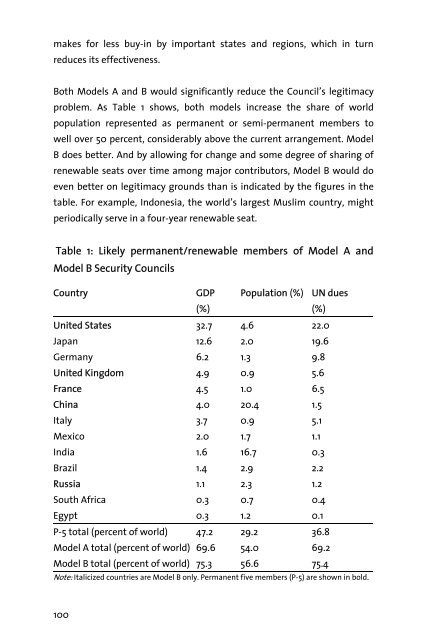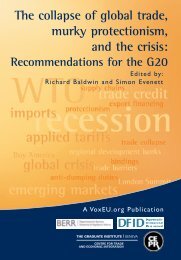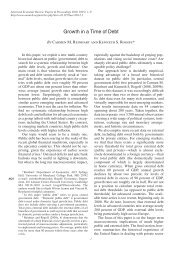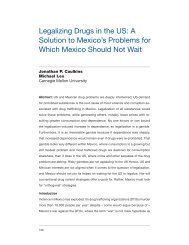- Page 1:
Reformingthe United Nationsfor Peac
- Page 5 and 6:
ContentsWorkshop ParticipantsvAckno
- Page 7 and 8:
ParticipantsWorkshop on United Nati
- Page 9:
Michael ReismanMyres S. McDougal Pr
- Page 13 and 14:
OverviewErnesto ZedilloDirector, Ya
- Page 15 and 16:
The important decision to make Secu
- Page 17 and 18:
member of the Panel’s Secretariat
- Page 19 and 20:
the new permanent members with a cl
- Page 21 and 22:
A model for a Security Council with
- Page 23 and 24:
criteria are intended not just to l
- Page 25 and 26:
TERRORISMThe Panel report urges the
- Page 27 and 28:
Participants also questioned the va
- Page 29 and 30:
FINAL CONSIDERATIONSThe High-level
- Page 31 and 32:
Promoting Democracy through Interna
- Page 33 and 34:
law—can channel internal dissent
- Page 35 and 36:
Many others had differences with th
- Page 37 and 38:
THE BEST KEPT SECRET: THE COMMUNITY
- Page 39 and 40:
Unfortunately, the Seoul Conference
- Page 41 and 42:
The important point is that the abi
- Page 43 and 44:
government by the Group’s most po
- Page 45 and 46:
Ministerial Meeting, the Convening
- Page 47 and 48:
2. Private foundations whose missio
- Page 49 and 50:
APPENDIX TO “PROMOTING DEMOCRACY
- Page 51 and 52:
The Report of the High-level Panel
- Page 53 and 54:
threats”. 28 So vulnerable indeed
- Page 55 and 56:
that the UN might be “facing a fo
- Page 57 and 58:
aw distributions of power and make
- Page 59 and 60:
Security Council. One of the Commis
- Page 61 and 62: The second message of the report st
- Page 63 and 64: vote of this member with veto power
- Page 65 and 66: GOVERNANCE IN THE ECONOMIC DOMAINWh
- Page 67 and 68: Comments on the Report of the High-
- Page 69 and 70: ecommendations would also have the
- Page 71 and 72: PANEL RECOMMENDATIONS ON ECONOMIC A
- Page 73 and 74: What is worse is that almost an exc
- Page 75 and 76: The conceptual underpinning of the
- Page 77 and 78: such an eventuality; and to assist
- Page 79 and 80: But it compromises on its own presc
- Page 81 and 82: The UN represents the highest level
- Page 83 and 84: The European Union in the United Na
- Page 85 and 86: In the UN, the European Common Fore
- Page 87 and 88: egard to resolutions put to a vote
- Page 89 and 90: The European Commission cautiously
- Page 91 and 92: The Group of Eastern European State
- Page 93 and 94: “respect … for international la
- Page 95 and 96: political declarations, especially
- Page 97 and 98: marginalization. If the Security Co
- Page 99 and 100: growth, the success of the democrat
- Page 101 and 102: Comments on the Report of the High-
- Page 103 and 104: • Regarding ECOSOC, the report ob
- Page 105 and 106: cause of international peace and se
- Page 107 and 108: • The Panel flatly rejects the ar
- Page 109 and 110: In Model A, six of the nine new sea
- Page 111: The Model A version of the new SC w
- Page 115 and 116: essence, the Panel is recommending
- Page 117 and 118: put under one purview. There are si
- Page 119 and 120: eviews of behavior in some area, be
- Page 121 and 122: A More Secure World? A Critique of
- Page 123 and 124: Recognizing the crisis of confidenc
- Page 125 and 126: creation of an international commis
- Page 127 and 128: The US commitment to the global rul
- Page 129 and 130: The closest the UN came to executin
- Page 131 and 132: them, as the Panel readily acknowle
- Page 133 and 134: Though the Panel offers very little
- Page 135 and 136: the concept of collective security
- Page 137 and 138: Assembly. Hopefully that input will
- Page 139 and 140: generally also asserted that, despi
- Page 141 and 142: shortcomings, as putting ever more
- Page 143 and 144: powerful pairing of arguments that
- Page 145 and 146: elsewhere and/or earlier. As discus
- Page 147 and 148: for radical reform from the Secreta
- Page 149 and 150: At San Francisco, the major powers
- Page 151 and 152: over process. The prevailing view,
- Page 153 and 154: significant power in its region. Th
- Page 155 and 156: consequential proposals in other ar
- Page 157 and 158: Indeed, if the Council is expanded
- Page 159 and 160: egard—whether measured individual
- Page 161 and 162: arriers to external intervention in
- Page 163 and 164:
Council, permanent or elected, have
- Page 165 and 166:
Security Council Expansion: Can’t
- Page 167 and 168:
importantly the quite proper concer
- Page 169 and 170:
superpowers in those situations whe
- Page 171 and 172:
Democratic majority (itself virtual
- Page 173 and 174:
developed countries known as the G-
- Page 175 and 176:
widely, an effective body might rea
- Page 177 and 178:
any US action. In much of the world
- Page 179 and 180:
Some Thoughts—Mostly Cautionary
- Page 181 and 182:
Panel Report goes further, however,
- Page 183 and 184:
• If the state fails in the midst
- Page 185 and 186:
the proactive rescue measures to th
- Page 187 and 188:
• There is a need for early and c
- Page 189 and 190:
HIV/AIDS could focus sustained glob
- Page 191 and 192:
THE SECURITY COUNCILEnlargement of
- Page 193 and 194:
model will depend, as at present, p
- Page 195 and 196:
Brief Notes on the Report of the Hi
- Page 197 and 198:
speech at Oxford in 1993. Ten years
- Page 199 and 200:
Negotiation difficulties, however,
- Page 201 and 202:
consensus but they embody little in
- Page 203 and 204:
NEGOTIATING CHARTER REFORMFor the a
- Page 205 and 206:
asic willingness to commit to a sys
- Page 207 and 208:
ecent Chapter VII resolutions have
- Page 210:
The Yale Center for the Study of Gl





